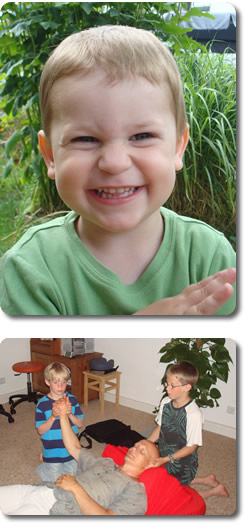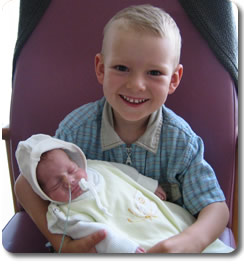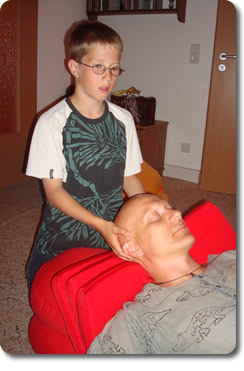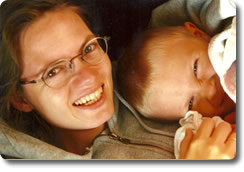Quick Links
What does a session look like? Your intention is important What can Craniosacral Therapy do for your child? Because of its softness, Craniosacral Therapy is especially suited for babies and children.
Because of its softness, Craniosacral Therapy is especially suited for babies and children.
In working with children it is important to me to not only have the parent’s consent for the session, but also the child’s or baby’s approval.
Even small children can be very clear in how they give permission. They have taken my hand and placed it on a certain area on their heads or bodies. They also have pushed my hand away or sought for more distance, indicating that they wanted a pause.
What does a session look like?
Depending on the age of your child, I might play with your toddler, talk with your older child about topics of its interest, or use other ways to bond and earn their trust, building a relationship that allows me to treat them.
Some children are eager to show me their favorite toy or book. Others love to play with toys, cushions, or medical models that I have in my practice room. Observing their games gives me additional information about your child, which will help the actual treatment and is therefore an important part of the session.
I might do a short hands-on demonstration on you as the parent to give your child the opportunity to observe first, before he or she gets touched.
While adults are usually lying down on a massage table for the craniosacral treatment, I can work with your child in almost any position he or she wants to be in. This can be on your lap, on the floor, sitting or standing… Children are often faster in their response to the treatment. It means the duration of a particular technique or touch can be much shorter than with adults. Multiple mini-pauses for movement or play during the session allow your child to integrate what happened.
With older children, often around school age, it is possible to spend more quiet time on the massage table. And the hands-on time will increase with the age of your child.
Your intention is important
As with adults, working with children also includes different layers, depending on your and your child’s wish or goal. It is possible to focus on the physical level, such as helping with the alignment of the spine or the cranial bones, creating more space for the inner organs to function better, or working with the nervous system. This more structural approach can even be done while your child is playing, reading a book with you, or is falling asleep.
 If the goal of the session is more on the emotional or psychological level – such as helping your child to integrate a challenging experience in order to overcome a certain anxiety or to sleep better… – playing serves another purpose in the session. It is part of the child’s expression about what is going on internally. Games are part of the story-telling, which provides important clues for me to work with, and for you as the parents to understand your child better, to make it easier to grow together as a family.
If the goal of the session is more on the emotional or psychological level – such as helping your child to integrate a challenging experience in order to overcome a certain anxiety or to sleep better… – playing serves another purpose in the session. It is part of the child’s expression about what is going on internally. Games are part of the story-telling, which provides important clues for me to work with, and for you as the parents to understand your child better, to make it easier to grow together as a family.
In a session like this, there might be less physical touch but more work on a certain behavior. For example, it might be very beneficial for your child to explore boundaries, or to make the experience that an adult like me accepts the communication of a “no” and is willing to negotiate the right distance or the suitable circumstances for physical contact.
In general, you as the parents or caregiver will be part of the session and in the room the whole time. With teenagers it might be beneficial to work with the adolescent alone, without the presence of a parent. This can be discussed to find the right solution for your family and situation.
What can Craniosacral Therapy do for your child?
Craniosacral Therapy is beneficial for your child in many situations. It will:

- Balance your child’s system before minor imbalances turn into a problem
- Help children with orthopedic and neurologic problems and diseases
- Support your child during challenging phases of development
- Support your child to recover faster and easier from injury, illness, and surgery, or to prepare your child for surgery
- Assist your child in integrating a difficult or challenging birth experience, or other traumatic events
- Help with sleeping challenges
- Improve one-sided or unbalanced posture or movement patterns
- Help to prepare your child for new situations, such as the arrival of a new baby, moving to another place, starting school, or dealing with the loss of a family member
- Support children with developmental delay
- Support children with learning difficulties or emotional difficulties
- Support children with attention-deficit hyperactivity disorder (ADHD)
- Support families with adopted children
- Support single parents and their children
- Support children with autism, and children with disabilities
- Alleviate side effects from vaccinations
- Provide additional therapy for children with severe medical conditions, such as heart failure or Down’s syndrome.
Please contact me if you have any questions or want to schedule an appointment. I am looking forward to hearing from you.

